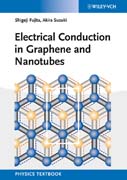
Written in a self–contained manner, this textbook allows both advanced students and practicing applied physicists and engineers to learn the relevant aspects from the bottom up. All logical steps are laid out without omitting steps. The book covers electrical transport properties in carbon based materials by dealing with statistical mechanics of carbon nanotubes and graphene ? presenting many fresh and sometimes provoking views. Both second quantization and superconductivity are covered and discussed thoroughly. An extensive list of references is given in the end of each chapter, while derivations and proofs of specific equations are discussed in the appendix. The experienced authors have studied the electrical transport in carbon nanotubes and graphene for several years, and have contributed relevantly to the understanding and further development of the field. The content is based on the material taught by one of the authors, Prof Fujita, for courses in quantum theory of solids and quantum statistical mechanics at the University at Buffalo, and some topics have also been taught by Prof. Suzuki in a course on advanced condensed matter physics at the Tokyo University of Science. For graduate students in physics, chemistry, electrical engineering and material sciences, with a knowledge of dynamics, quantum mechanics, electromagnetism and solid–state physics at the senior undergraduate level. Includes a large numbers of exercise–type problems. INDICE: Preface XI Physical Constants, Units, Mathematical Signs and Symbols XV 1 Introduction1 1.1 Carbon Nanotubes 1 1.2 Theoretical Background 4 1.3 Book Layout 8 1.4 Suggestions for Readers 9 References 10 2 Kinetic Theory and the Boltzmann Equation 11 2.1 Diffusion and Thermal Conduction 11 2.2 Collision Rate: Mean Free Path 12 2.3 Electrical Conductivity and Matthiessen’s Rule 15 2.4 The Hall Effect: “Electrons” and “Holes” 17 2.5 The Boltzmann Equation 19 2.6 The Current Relaxation Rate 21 References 25 3 Bloch Electron Dynamics 27 3.1 Bloch Theorem in One Dimension 27 3.2 The Kronig–Penney Model 30 3.3 Bloch Theorem in Three Dimensions 33 3.4 Fermi Liquid Model 36 3.5 The Fermi Surface 37 3.6 Heat Capacity and Density of States 40 3.7 The Density of State in the Momentum Space 42 3.8 Equations of Motion for a Bloch Electron 46 References 51 4 Phonons and Electron–Phonon Interaction 53 4.1 Phonons and Lattice Dynamics 53 4.2 Van Hove Singularities 57 4.3 Electron–Phonon Interaction 65 4.4 Phonon–Exchange Attraction 71 References 75 5 Electrical Conductivity of Multiwalled Nanotubes 77 5.1 Introduction 77 5.2 Graphene 78 5.3 Lattice Stability and Reflection Symmetry 81 5.4 Single–Wall Nanotubes 84 5.5 Multiwalled Nanotubes 85 5.6 Summary and Discussion 87 References 89 6 Semiconducting SWNTs 91 6.1 Introduction 91 6.2 Single–Wall Nanotubes 93 6.3 Summary and Discussion 98 References 98 7 Superconductivity 99 7.1 Basic Properties of a Superconductor 99 7.2 Occurrence of a Superconductor 105 7.3 Theoretical Survey 107 7.4 Quantum Statistical Theory of Superconductivity 111 7.5 The Cooper Pair Problem 114 7.6 Moving Pairons 116 7.7 The BCS Ground State 119 7.8 Remarks 126 7.9 Bose–Einstein Condensation in 2D 133 7.10 Discussion 137 References 139 8 Metallic (or Superconducting) SWNTs 141 8.1 Introduction 141 8.2 Graphene 147 8.3 The Full Hamiltonian 149 8.4 Moving Pairons 151 8.5 The Bose–Einstein Condensation of Pairons 153 8.6 Superconductivity in Metallic SWNTs 157 8.7 High–Field Transport in Metallic SWNTs 159 8.8 Zero–Bias Anomaly 161 8.9 Temperature Behavior and Current Saturation 162 8.10 Summary 162 References 164 9 Magnetic Susceptibility 165 9.1 Magnetogyric Ratio 165 9.2 Pauli Paramagnetism 167 9.3 The Landau States and Levels 170 9.4 Landau Diamagnetism 171 References 176 10 Magnetic Oscillations 177 10.1 Onsager’s Formula 177 10.2 Statistical Mechanical Calculations: 3D 181 10.3 Statistical Mechanical Calculations: 2D 184 10.4 Anisotropic Magnetoresistance in Copper 189 10.5 Shubnikov–de Haas Oscillations 196 References 201 11 Quantum Hall Effect 203 11.1 Experimental Facts 203 11.2 Theoretical Developments 206 11.3 Theory of the Quantum Hall Effect 208 11.4 Discussion 218 References 219 12 Quantum Hall Effect in Graphene 221 12.1 Introduction 221 References 227 13 Seebeck Coefficient in Multiwalled Carbon Nanotubes 229 13.1 Introduction 229 13.2 Classical Theory of the Seebeck Coefficient in a Metal 232 13.3 Quantum Theory of the Seebeck Coefficient in a Metal 235 13.4 Simple Applications 239 13.5 Graphene and Carbon Nanotubes 240 13.6 Conduction in Multiwalled Carbon Nanotubes 242 13.7 Seebeck Coefficient in Multiwalled Carbon Nanotubes 243 References 246 14 Miscellaneous 247 14.1 Metal–Insulator Transition in Vanadium Dioxide 247 14.2 Conduction Electrons in Graphite 249 14.3 Coronet Fermi Surface in Beryllium 250 14.4 Magnetic Oscillations in Bismuth 251 References 251 Appendix 253 A.1 Second Quantization 253 A.2 Eigenvalue Problem and Equation–of–Motion Method 261 A.3 Derivation of the Cooper Equation (7.34) 267 A.4 Proof of (7.94) 270 A.5 Statistical Weight for the Landau States 271 A.6 Derivation of Formulas (11.16)–(11.18) 273 References 274 Index 275
- ISBN: 978-3-527-41151-1
- Editorial: Wiley VCH
- Encuadernacion: Rústica
- Páginas: 306
- Fecha Publicación: 14/08/2013
- Nº Volúmenes: 1
- Idioma: Inglés
